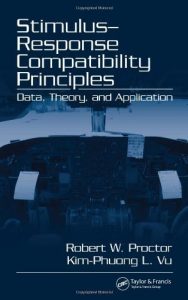Understanding of the factors that influence stimulus-response (S-R) compatibility and determine when and how compatibility effects will arise is a necessary foundation for appropriately applying compatibility principles in design and for evaluating the relative compatibility of alternative designs. Summarizing the state of contemporary knowledge regarding determinants of compatibility, Stimulus-Response Compatibility Principles: Data, Theory, and Application provides thorough, up-to-date coverage of basic and applied research coupled with an emphasis on relating this knowledge to specific design guidelines.
Examining a broad range of theoretical and applied issues from the compatibility perspective, the authors review basic research devoted to theoretical issues concerning S-R compatibility in particular and the relation between perception and action more generally. They cover effects of different S-R mappings in simple and complex tasks, factors that influence response-selection efficiency, correspondence effects of irrelevant stimulus information, compatibility effects for multiple and orthogonal dimensions, consequences of mixing mappings and tasks, practice and transfer effects, compatibility effects in multiple-task performance, and direction of motion stereotypes. The authors provide a thorough treatment of alternative views, contrasting and comparing their strengths and weaknesses. They provide guidelines that incorporate current knowledge about compatibility effects.
Previous books on S-R compatibility have been edited works that contained detailed descriptions of the findings of various research programs across the world. Consequently, those books do not provide a cohesive overview of the range of research on compatibility effects, and the treatments they provide are not easy to comprehend by individuals who lack a background in the area. Making information accessible to a broad range of researchers and practitioners, this text organizes, summarizes, and integrates the vast amount of knowledge concerning S-R compatibility.
Examining a broad range of theoretical and applied issues from the compatibility perspective, the authors review basic research devoted to theoretical issues concerning S-R compatibility in particular and the relation between perception and action more generally. They cover effects of different S-R mappings in simple and complex tasks, factors that influence response-selection efficiency, correspondence effects of irrelevant stimulus information, compatibility effects for multiple and orthogonal dimensions, consequences of mixing mappings and tasks, practice and transfer effects, compatibility effects in multiple-task performance, and direction of motion stereotypes. The authors provide a thorough treatment of alternative views, contrasting and comparing their strengths and weaknesses. They provide guidelines that incorporate current knowledge about compatibility effects.
Previous books on S-R compatibility have been edited works that contained detailed descriptions of the findings of various research programs across the world. Consequently, those books do not provide a cohesive overview of the range of research on compatibility effects, and the treatments they provide are not easy to comprehend by individuals who lack a background in the area. Making information accessible to a broad range of researchers and practitioners, this text organizes, summarizes, and integrates the vast amount of knowledge concerning S-R compatibility.






